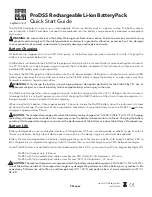
INSTALLING THE AT10.1
22
8. Check your work. Confirm that:
•
All connections are secure.
•
The shield is connected to ground at the
charger end only
(A1-J6).
•
The cable is connected to the 2-position terminal block (TB8) on the
Main Control PC Board (A1). Other terminal blocks may look similar.
9. Restart the AT10.1 using the startup procedure in Section 2.1. During
startup, the AT10.1 displays
Pb
on the front panel meter, indicating that the
temperature compensation is set up for lead-acid battery types. While this is
being displayed, you can press any front panel key to change the display to
read
nicd
, to change the temperature compensation setup for nickel-
cadmium batteries. The choice you make is saved internally, and will be
used again by the AT10.1 the next time it starts.
10. Adjust the output float and equalize voltages to the battery manufacturer's
recommended values, using the AT10.1 front panel meter, as described in
Section 2.3.2.
NOTICE
If the temperature compensation probe, or the probe wiring, is
damaged and becomes an open circuit, the AT10.1 detects the
damage and displays
E 08
on the front panel meter. The
AT10.1 then reverts to normal non-temperature-compensated
operation until the probe or wiring is repaired. Once the probe
is repaired, you must restart the AT10.1 to activate the probe,
as described in Section 2.1.
Using temperature compensation
When an electric storage battery is being charged, the terminal voltage of
the battery changes a small amount whenever the battery temperature
changes. As the battery temperature increases, its terminal voltage
decreases. When a constant output voltage float type rectifier charges a
battery, float current increases when the temperature increases. This
results in overcharging the battery, which can result in damage to the
materials, or at least the need for more frequent maintenance.
When the AT10.1 is equipped with a temperature compensation probe, it
is able to adjust the output voltage applied to the battery to keep the float
current constant, thereby avoiding overcharging. The probe senses the
ambient temperature at the battery, and adjusts the output float/equalize
voltages to compensate for variations in temperature. If the ambient
temperature increases, the AT10.1 output voltage decreases.
If you are experiencing any inconsistencies in the AT10.1 when the
temperature compensation probe is utilized, temporarily disconnect the
probe, and refer to the
Application Note
(
JD5003-00
) for further details.
Содержание AT10.1 SERIES
Страница 78: ...APPENDIX C 72 Outline AT10 1 Group II Battery Charger NEMA 1 Style 5017 Enclosure JE5025 00...
Страница 79: ...APPENDIX C 73 http www ATSeries net PDFs JE5025 00 pdf...
Страница 80: ...APPENDIX C 74 Outline AT10 1 Group II Battery Charger NEMA 1 Style 5018 Enclosure JE5026 00...
Страница 81: ...APPENDIX C 75 http www ATSeries net PDFs JE5026 00 pdf...
Страница 83: ...APPENDIX C 77 http www ATSeries net PDFs JE5028 99 pdf...
Страница 85: ...APPENDIX C 79 http www ATSeries net PDFs JE5029 99 pdf...
Страница 87: ...APPENDIX C 81 http www ATSeries net PDFs JE5030 29 pdf...
Страница 88: ...APPENDIX C 82 Schematic AT10 1 Group II Battery Charger Standard w o Options JE5032 00...
Страница 89: ...APPENDIX C 83 http www ATSeries net PDFs JE5032 00 pdf...
Страница 90: ...APPENDIX C 84 Schematic AT10 1 Group II Battery Charger w Common Options JE5032 99...
Страница 91: ...APPENDIX C 85 http www ATSeries net PDFs JE5032 99 pdf...
Страница 92: ...APPENDIX C 86 Connection Diagram AT10 1 Group II Battery Charger Standard w o Options JE5034 00...
Страница 93: ...APPENDIX C 87 http www ATSeries net PDFs JE5034 00 pdf...
Страница 94: ...APPENDIX C 88 Connection Diagram AT10 1 Group II Battery Charger w Common Options JE5034 99...
Страница 95: ...APPENDIX C 89 http www ATSeries net PDFs JE5034 99 pdf...
Страница 101: ...USER NOTES 95...
















































